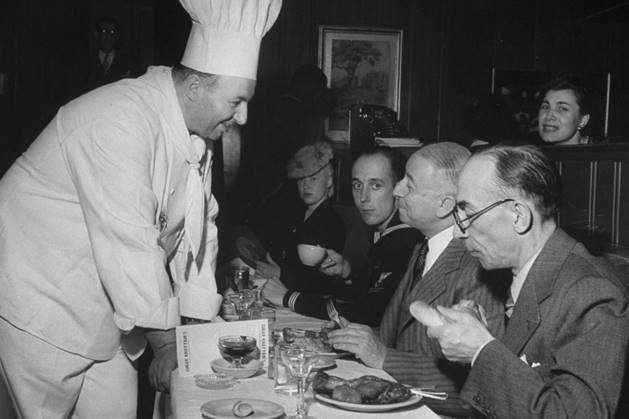George Mardikian’s Arkayagan Abour (Royal Soup) from Dinner at Omar Khayyam’s

SAN FRANCISCO — “George Mardikian (1903-1977) channeled the pain and hunger from his survival of the Armenian Genocide: He went from a dishwasher to a world-famous San Francisco restaurant owner who won the Presidential Medal of Freedom in 1951 for his work in the Army and dedicated his life to feeding people,” writes Greg Keraghosian, at SFGATE.
Mardikian’s Omar Khayyam’s was the dining destination for San Franciscans for over 40 years at its underground location near the corner of Powell and O’Farrell streets. Celebrities, politicians, and professionals paid upscale prices while armed service members and refugees ate for free. Its authentic shish kebab and bulgur pilaf were the main draw for a largely American clientele unfamiliar with such food. But the restaurant drew its life force from, as William Saroyan called him, “the big man with the bright face coming over to your table.”
In Dinner at Omar Khayyam’s, Mardikian’s cookbook for all Americans, America’s first celebrity chef reveals the culinary secrets that made his San Francisco establishment so revered. “The recipes are for Armenian food, prepared in the Armenian fashion, but seasoned to the American palate. Dishes were exotic and different, but thrifty, healthful, and easy, even for amateur chefs to prepare. His food was sophisticated enough for parties, but economical and well balanced enough to serve the whole family.”
He wrote, “I have found records of the authentic origin of Royal Soup in monasteries in various parts of old Armenia. Here Armenian monks have saved the most precious Armenian manuscripts for sixteen centuries. It was in one of these 1500-year-old manuscripts that I found out why this soup is called Royal Soup or Victory Soup. Over 3,500 years ago, when an Armenian king went to war and came back victorious it was his solemn day to go into the rich forests and bring back all sorts of wild birds and gazelles. He would bring the game to the palace steps where a huge gatsa or kettle had been placed by coppersmiths. After his servants had cleaned the gazelles and birds, the king with his own hands would prepare the Royal Soup and serve it to the princes and princesses of his court, who in turn would serve the public who had come from every part of Armenia to celebrate the victory.”
“As the game and birds became scarce, Armenians tried to find other ways to make the soup. Now instead of serving huge chunks of gazelle and pheasant meat, they substituted chicken broth, and made the meatballs out of deer meat. As culinary art has progressed, they have added zest to the soup for flavoring. In the olden days they used to put young grapes into the soup for flavoring. Now they add lemon juice and eggs beaten together. It gives a delightful flavor that you can’t find in anything else.”






